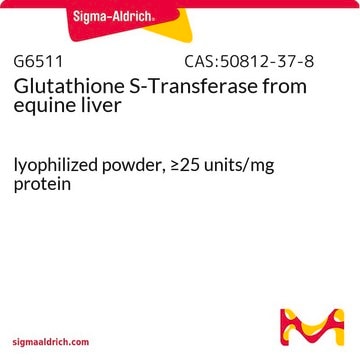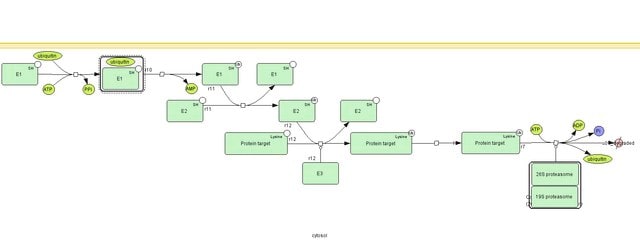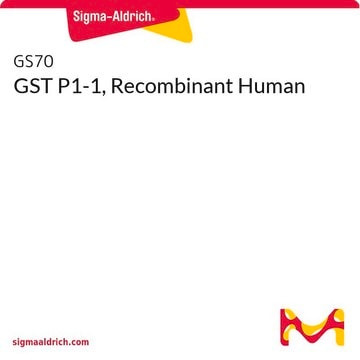SRP5348
GST protein, tag-free
recombinant, expressed in E. coli, ≥70% (SDS-PAGE), buffered aqueous glycerol solution
Sign Into View Organizational & Contract Pricing
All Photos(1)
About This Item
Recommended Products
recombinant
expressed in E. coli
Assay
≥70% (SDS-PAGE)
form
buffered aqueous glycerol solution
mol wt
~25 kDa
technique(s)
ligand binding assay: suitable
NCBI accession no.
shipped in
dry ice
storage temp.
−70°C
Gene Information
Escherichia coli IAI39 ... gst> gst
gst(7152360)
General description
Glutathione S-transferase (GST) family of enzymes comprises a long list of cytosolic, mitochondrial and microsomal proteins that are used to create the so-called GST gene fusion system. These proteins are capable of multiple reactions with a multitude of substrates. They have a role in detoxication and toxification mechanisms. GST tag has the size of 220 amino acids, which is relatively large compared to other tags like the myc- or the FLAG-tag that are quite small. GST can be used to purify and detect proteins of interest. In a GST gene fusion system, an expression vector consists of the gene sequence encoding the protein of interest and GST sequence alongside. After induction, the fusion proteins can be purified using affinity chromatography via its high affinity for glutathione.
Application
GST protein, tag-free has been used in in vitro F-actin binding assay. It has also been used as a protein tag for TPX2 (targeting protein for Xklp2).
Physical form
Supplied in 50 mM Tris-HCl, pH 7.5, 150 mM NaCl, 10 mM glutathione, 0.1 mM EDTA, 0.25 mM DTT, 0.1 mM PMSF, 25% glycerol.
Preparation Note
After opening, aliquot into smaller quantities and store at -70 °C. Avoid repeating handling and multiple freeze/thaw cycles.
Storage Class Code
10 - Combustible liquids
WGK
WGK 1
Flash Point(F)
Not applicable
Flash Point(C)
Not applicable
Certificates of Analysis (COA)
Search for Certificates of Analysis (COA) by entering the products Lot/Batch Number. Lot and Batch Numbers can be found on a product’s label following the words ‘Lot’ or ‘Batch’.
Already Own This Product?
Find documentation for the products that you have recently purchased in the Document Library.
Customers Also Viewed
Identification of small molecule inhibitors of the Aurora-A/TPX2 complex
Asteriti IA, et al.
Testing, 8(12), 32117-32117 (2017)
Cdc42EP3/BORG2 and Septin Network Enables Mechano-transduction and the Emergence of Cancer-Associated Fibroblasts.
Calvo F
Cell Reports, 13(12), 2699-2714 (2015)
Nanami Kikuchi et al.
ACS synthetic biology, 11(4), 1389-1396 (2022-04-05)
We present a cell-free assay for rapid screening of candidate inhibitors of protein binding, focusing on inhibition of the interaction between the SARS-CoV-2 Spike receptor binding domain (RBD) and human angiotensin-converting enzyme 2 (hACE2). The assay has two components: fluorescent
Italia Anna Asteriti et al.
Oncotarget, 8(19), 32117-32133 (2017-04-09)
Aurora kinases are a family of cell division regulators that govern the correct assembly of a bipolar mitotic spindle and the fidelity of chromosome segregation. Their overexpression is associated with genomic instability and aneuploidy, and is frequently observed in cancer.
Yujing Li et al.
Nature communications, 9(1), 4394-4394 (2018-10-24)
Heterozygous deletion of chromosome 17p (17p) is one of the most frequent genomic events in human cancers. Beyond the tumor suppressor TP53, the POLR2A gene encoding the catalytic subunit of RNA polymerase II (RNAP2) is also included in a ~20-megabase
Our team of scientists has experience in all areas of research including Life Science, Material Science, Chemical Synthesis, Chromatography, Analytical and many others.
Contact Technical Service










